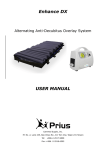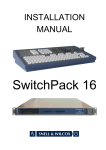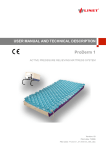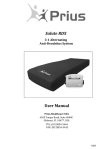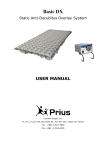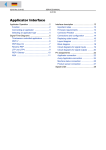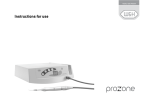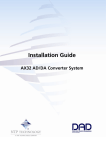Download User manual - ASSIST - modified by Grace - 2012.03.19
Transcript
Assist Full Automatically Alternating Pressure Relief Replacement System USER MANUAL Caremed Supply, Inc. 7F, No. 2, Lane 235, Bao Chiao Rd., Xin Tien City, Taipei 231 Taiwan Tel: +886-2-2917-9808 Fax: +886 -2-2918-6505 Warning * Connect the Master Control unit to a 100 ~240 volt power source. * Keep the pump and mattress away from open flame. * Keep the mattress away from sharp objects. * Do not place a heating device close to the mattress system. Caution * The System should always be used in accordance with your Institutions pressure care guidelines. * Re-positioning of the patient is always recommended when using an Alternating Pressure Air Mattress (APAM). * The Control unit can only be repaired by an authorized technician. * Do not drop the control unit. * Operation Temp: 15°C ~ 40°C R.H. : 30% ~ 75 % 1 Contents 1. The Purpose of this Manual P. 1 2. Intended Use P. 1 3. Introduction P. 1 4. Operation instruction P. 2 5. Technical Data P. 8 6. Cleaning P. 9 7. Storage and Transportation P. 10 8. Waste Disposal P. 10 9. Maintenance and Trouble Shooting P. 11 10. EMC Related Notifications P. 12 11. Symbol Definition P. 15 1. The Purpose of this Manual This operation manual is mainly focused on the set up, cleaning and routine maintenance of the Assist Alternating Pressure Mattress Replacement System. We recommend to keep this manual in a safe place, to be able to use it when required. 2. Intended use The Assist Alternating Pressure Mattress Replacement System is primarily used for the treatment and prevention of decubitus ulcers up to stage IV. The System includes the latest technology of alternating mattress therapy which enables the mattress overlay to perform accurate pressure setting to individual patients needs. The Assist Mattress Replacement System is one of the most advanced sensor technology systems, for patients with high to very high risk for pressure sores. 3. Introduction Handle Hook Set Control Panel Filter Label area Front view Back view Sensor Power Cord Air Outlet Right side view Left side view 1 Control Panel User could press the button on the control panel to operate the function. Label Area Place for label (company logo label or operation label) Hook Set Remove the control unit from the box, pop-up the fixation hooks and place the unit at the foot end of the bed. Air Outlet Plate Connect the mattress to the control unit by plugging in the air tubes set (mattress side) to the air outlet plate (control unit side). Make sure the plug is connected properly, by hearing a ‘click’. Filter Device The Air Filter should be cleaned and checked as often as possible at a minimum of every six months. Air Filter can be removed by pulling outwards from the back of the control unit. Cleaning procedure for air filter 1. Remove Air filter and Replace a new Filter. 2. Use a soft brush to remove dust. CAUTION 1. Do not use phenol based cleaning solutions. 2. Switch off the electrical supply to the pump and disconnect the power cord from the main supply before cleaning and inspection) 3. Storage and care. Power Cord Plug in the control unit and turn on the switch. CAUTION Make sure the voltage is AC 100 ~ 240 Volt. Sensor Connect the sensor from mattress to control unit. 4. Operation instruction 4.1 Installation 1. Unpack the system and place the pump at the foot end of the bed. 2. Remove the existing mattress and place the support surface directly onto the bed frame with the vapor permeable cover on top, ensuring that the inflation tubes are at the foot end of the bed. 3. Connect the air hoses from the mattress to the CPC connector on the side of the pump. 4. Turn on the pump unit. 5. The pump indicators will illuminate. The pump will start to inflate the air mattress. 6. Set the required pressure of the system by turning the pressure dial until the arrow on the dial is pointing at the required pressure setting. 2 7. Before repositioning the patient, wait 5 minutes after the low pressure LED has gone out. Moving the patient just after the LED goes out may activate the alarm. Note : The inflation time should not exceed 25 minutes. 4.2 Contol unit (pump) Mode switch (Auto/Manual, Alternating/Static) Pressure adjustment (+) LCD Display Transfer Mode Audio Alarm On/Off Control panel lock On/Off Auto Firm mode Pressure adjustment (-) Power On/Stand-By mode 3 LCD Display introduction: Static Mode Alternating Mode Manual Automatic Battery power (Transfer Mode) AC power (Transfer Mode) Alarm on Alarm off Lock Max Inflate Mode Battery Capacity indicate Power failure Out of Sensor Pressure Level indicate Low Pressure 4.3 Operating instruction 4.3.1 Power On/Stand-By Plug the power cord to the socket and switch on the power at the power air outlet, the Orange LED will illuminate, which means Stand-by, please see below picture (Picture 4.3.1.1). Press the button Power On/Stand-By button, the LED light will turn to green, and the control unit will start to operate, please see below picture (Picture 4.3.1.2). The LCD display will display the last setting. 4 (Picture 4.3.1.1) (Picture 4.3.1.2) 4.3.2 Mode selection Under Normal operating, press mode button switch to Alternate mode or Static mode Alternate mode Manual Alternate Mode Automatic Alternate Mode Static mode Manual Static Mode Automatic Static Mode 4.3.3 Maximum inflation Mode Under normal operating, press MAX button to switch to Maximum inflation mode ,the green LED of MAX will illuminated. (Picture 4.3.3.1) MAX mode: Under MAX mode, the control unit will automatic switch to static mode with maximum pressure range - level 10. The setting will return back to original operating status after 30 minutes. To cancel the MAX mode, just press MAX button again, and will return to previous status. (Picture 4.3.3.1) 5 4.3.4 Lock On/Off When the pump has been activated, the pump will automatically lock on after 1 minute without operation, and press the lock On/Off button for 3 seconds to unlock. All the buttons will be locked under Lock function except “MAX” function. (Picture 4.3.4.1) (Picture 4.3.4.1) 4.3.5 Transport function “Transfer” function is unable to switch the AC power to battery power, and the user can use this function to do transferring. (Picture 4.3.5.1) When pressing the transfer mode, the LED light of the transfer mode will flash, and will detect the power status with audio alarm. After 2 minutes of detecting, (A) If the AC power is already unplugged, the LED light will be illuminated permanently and the audio alarm will be automatically turned off. And the pump will switch to Static mode. The audio alarm will be activated every 15 minutes for reminder (3 beeps per second), the alarm will be activated in 15 minutes, 30 minutes, and 45 minutes. In 55 minutes, the audio alarm will continue to beep until the AC power is plugged in. (B) If the AC power is still plugged after 2 minutes of detecting, the pump will automatically returns to previous setting. (Picture 4.3.5.1) 4.3.6 Alarm On/Off Press Alarm on/off to switch on/off the audio alarm. (Picture 4.3.6.1) (Picture 4.3.6.1) 6 4.3.7 Pressure setting Adjust the pressure using the (+/-) button, the level of pressure will be displayed on the LCD panel. (picture 4.3.7.1) (Picture 4.3.7.1) 4.3.8 Automatic Mode Plug in the connector of sensor pad to the control unit. The sensor will automatic detect the weight of the user and select the correspondence pressure range automatically. If the Sensor pad is not plugged in properly, when switched to the Automatic mode, the alarm will be activated. And the sign of “out of sensor” will be flashing on the LCD display until the sensor has been plugged in properly. The sensor will detect every hour under Automatic mode the pressure of the client. 4.3.9 Power Failure When there is a AC power failure, the power failure alarm will be activated. And the Power failure sign will be displayed on the LCD display, and the power will switch to the battery used sign. 7 4.3.10 Battery Capacity The LCD display will show the capacity of battery. And the battery will be charged when connected to AC power. When the battery capacity is full, the power of battery is minimum 1 hour. 4.3.11 Low Pressure Alarm During operation period, if the pressure in the mattress is insufficient for over 30 minutes, the audio alarm will be activated, and the Low pressure sign will be illuminated on the LCD display. 5. Technical Data Master Control Unit Model name Assist Model No. M19 Part No. FC-PHE0003 Size (cm) 27.5(L) x 13.3(W) x 32.6(H) Weight (kg) 6 Cycle Time (min) 8.5 min Min/Max Pressure 17 ~ 30 mmHg +/- 5 mmHg Max Flow-rate 7 L/min Rated Voltage AC 100~240 volt Max Current 0.2 A Fuse Rating T1AH 250V Rated Frequency 50/60 Hz Protection Type Class II, Type BF Not AP or APG Type Mode of Operation Continuous 8 Mattress Replacement Mattress type 20 cm Replacement + sensor pad Model No. FM-PHE0006 Size (mm) 200cm(L) x 90cm(W) x 20cm(H) Weight (kg) 10.6 kg Cell Material PU coated Nylon Cover Type Full Cover with zipper Cover Material 2-way stretch PU coated Nylon, Blue color Base Material PVC Mesh, Black color Number of Cells 20 Maximum Weight Capacity 230 kg 6. Cleaning The mattress should be cleaned on the bed weekly using a damp soft cloth and mild detergent. If top sheet (Top cover) or base (Bottom cover) becomes very dirty, put on clean gloves, plastic clothing and eye protection before removing top sheet or base and disposing according to standard hospital procedures for contaminated waste. Replace with clean covers. Covers can be washed and thermally disinfected in a washing machine following below procedure: (Never use phenol based cleaning solutions) Industrial Domestic Break washes Main washes Main washes Extraction 3 Cold Rinses Extraction Pre-wash Main Wash Extraction Cold Rinses Extraction Cold 60∘C 70∘C Cold 70∘C 10 minutes 6 minutes 10 minutes 2 minutes 5 minutes 10 minutes 2 minutes 5 minutes Article I. Mattress Cells can be wiped over with a solution of sodium hypochlorite 1000ppm or any other non-phenolic germicidal solution. Master Control Unit SWITCH OFF THE ELECTRICAL SUPPLY TO THE PUMP AND DISCONNECT THE POWER CORD FROM THE MAIN SUPPLY BEFORE CLEANING AND INSPECTION 9 The pump unit should also be cleaned weekly using a damp soft cloth and mild detergent. The pump casing is manufactured from ABS plastic and if the case is soiled the pump can be wiped down with a sodium hypochlorite solution to dilution of 1000ppm or any EPA- approved hospital grade disinfectant. (Do not use phenol based cleaning solution) 7. Storage and Transportation Master Control Unit Storage and transportation conditions Temperature limitations: 5°C ~ 60°C Relative humidity: 30% ~ 75% l Check the power cord and plug for scratches or extreme damage. l Plug in the unit and verify air flows from the units hose connection ports l Place the unit in plastic bag for storage. Overlay Mattress l Check the air manifold for nods or damage. Replace if necessary. l Twist the CPR plug at the head of the mattress and disconnect the air feed tubes. All the air will be expelled. Starting at the head end, the mattress can now be rolled. Use the base mounted straps for rolling up the mattress. l Place the mattress in plastic bag for storage. It is recommended the following guidelines are used whenever this system is being stored or transported to another location: Temperature limitations: 15∘C ~ 40∘C Relative Humidity: 30% ~ 75% 8. Waste Disposal This Product has been supplied from an environmentally aware manufacturer that complies with the WEEE. This product may contain substances that could be harmful to the environment if disposed of in places (landfills) that are not appropriate according the legislation. Please be environmentally responsible and recycle this product through your recycling facility at its end of life. 10 9. Maintenance & Troubleshooting No daily maintenance is required. It is intended that this equipment should only be serviced by an qualified, authorized technical personnel. In case of minor troubleshooting please refer to the following troubleshooting schedule: Symptom Inspection Procedure Possible Solution Pump not operating 1. Power terminal may not be secured 1. Check for power terminal or properly or incorrect voltage main voltage connected. 2. Replace PC board 2. PC board malfunctions. 3. Replace fuse 3. Fuses burn down Pump functioning but no air out put 1. Bello diaphragm in compressor could be worn out. 2. Internal air tubing may become loose 1. Replace diaphragm 2. Secure tubing inside the pump 3. Replace coil 3. Coil inside the compressor unit worn out No Alternation or LED indicator does not light up immediately. 1. 2. Possible loose wire connection for motor timer and micro switch. Time motor worn out or broke down. 3. Micro switch broke down 4. LED indicator broke down 1. Secure wire connections. 2. Replace motor timer 3. Replace micro switch 4. Replace circuit board Low Pressure light 1. Check for functionality of pressure 1. Replace pressure control does not turn off control module. module after mattress is fully 2. Possible PC board malfunctions. 2. Replace PC board. inflated No audio alert during 1. Audio alarm switch may be turned 1. Turn the switch to ON power cut/power off. position. outage. 2. Audio alarm switch malfunction 2. Replace alarm circuit board 11 10. EMC related notifications Guidance and manufacturer’s declaration – electromagnetic emissions The Equipment is intended for use in the electromagnetic environment specified below. The customer or the user of the Equipment should assure that it is used in such an environment. Emissions test RF emissions Compliance Electromagnetic environment – guidance Group 1 The Equipment uses RF energy only for its internal function. Therefore, its RF emissions are very low and are not likely to cause any interference in nearby electronic equipment. Class B The Equipment is suitable for use in all establishments, including domestic establishments and those directly connected to the public lowvoltage power supply network that supplies buildings used for domestic purposes. CISPR 11 RF emissions CISPR 11 Harmonic emissions Class A IEC 61000-3-2 Voltage fluctuations/ Complies flicker emissions IEC 61000-3-3 Recommended separation distances between portable and mobile RF communications equipment and the Equipment The Equipment is intended for use in an electromagnetic environment in which radiated RF disturbances are controlled. The customer or the user of the Equipment can help prevent electromagnetic interference by maintaining a minimum distance between portable and mobile RF communications equipment (transmitters) and the Equipment as recommended below, according to the maximum output power of the communications equipment. Rated maximum output power of transmitter W Separation distance according to frequency of transmitter m 150 kHz to 80 MHz d = 1,2 80 MHz to 800 MHz d = 1,2 800 MHz to 2,5 GHz d = 2,3 0,01 0,12 0,12 0,23 0,1 0,38 0,38 0,73 1 1,2 1,2 2,3 10 3,8 3,8 7,3 100 12 12 23 For transmitters rated at a maximum output power not listed above, the recommended separation distance d in metres (m) can be estimated using the equation applicable to the frequency of the transmitter, where P is the maximum output power rating of the transmitter in watts (W) according to the transmitter manufacturer. NOTE 1 At 80 MHz and 800 MHz, the separation distance for the higher frequency range applies. NOTE 2 These guidelines may not apply in all situations. Electromagnetic propagation is affected by absorption and reflection from structures, objects and people. 12 Guidance and manufacturer’s declaration – electromagnetic immunity The Equipment is intended for use in the electromagnetic environment specified below. The customer or the user of the Equipment should assure that it is used in such an environment. Immunity test IEC 60601 test level Compliance level Electromagnetic environment – guidance Electrostatic discharge (ESD) IEC 61000-4-2 ±6 kV contact ±8 kV air ±6 kV contact ±8 kV air Floors should be wood, concrete or ceramic tile. If floors are covered with synthetic material, the relative humidity should be at least 30 %. Electrical fast transient/burst ±2 kV for power supply lines ±2 kV for power supply lines Mains power quality should be that of a typical commercial or hospital environment. IEC 61000-4-4 ±1 kV for input/output lines ±1 kV for input/output lines Surge IEC 61000-4-5 ±1 kV line(s) to line(s) ±1 kV line(s) to line(s) ±2 kV line(s) to earth ±2 kV line(s) to earth <5 % UT (>95 % dip in UT) for 0,5 cycle <5 % UT (>95 % dip in UT) for 0,5 cycle 40 % UT (60 % dip in UT) for 5 cycles 40 % UT (60 % dip in UT) for 5 cycles 70 % UT (30 % dip in UT) for 25 cycles 70 % UT (30 % dip in UT) <5 % UT (>95 % dip in UT) for 5 sec <5 % UT (>95 % dip in UT) interruptions and voltage variations on power supply input lines IEC 61000-4-11 Power frequency (50/60 Hz) magnetic field 3 A/m Mains power quality should be that of a typical commercial or hospital environment. Mains power quality should be that of a typical commercial or hospital environment. If the user of the Equipment] requires continued operation during power mains interruptions, it is recommended that the Equipment be powered from an uninterruptible power supply or a battery. for 25 cycles for 5 sec Power frequency magnetic fields should be at levels characteristic of a typical location in a typical commercial or hospital environment. 3 A/m IEC 61000-4-8 NOTE UT is the a.c. mains voltage prior to application of the test level. 13 Guidance and manufacturer’s declaration – electromagnetic immunity The Equipment is intended for use in the electromagnetic environment specified below. The customer or the user of the Equipment should assure that it is used in such an environment. Immunity test IEC 60601 test level Compliance level Electromagnetic environment – guidance Portable and mobile RF communications equipment should be used no closer to any part of the Equipment, including cables, than the recommended separation distance calculated from the equation applicable to the frequency of the transmitter. Recommended separation distance Conducted RF IEC 610004-6 Radiated RF IEC 610004-3 3 Vrms 150 kHz to 80 MHz 3 V/m 80 MHz to 2,5 GHz d = 1,2 3 Vrms d = 1,2 80 MHz to 800 MHz d = 2,3 800 MHz to 2,5 GHz 3 V/m where P is the maximum output power rating of the transmitter in watts (W) according to the transmitter manufacturer and d is the recommended separation distance in metres (m). Field strengths from fixed RF transmitters, as determined by an electromagnetic site survey, B should be less than the compliance level in each frequency range. B Interference may occur in the vicinity of equipment marked with the following symbol: NOTE 1 At 80 MHz and 800 MHz, the higher frequency range applies. NOTE 2 These guidelines may not apply in all situations. Electromagnetic propagation is affected by absorption and reflection from structures, objects and people. a Field strengths from fixed transmitters, such as base stations for radio (cellular/cordless) telephones and land mobile radios, amateur radio, AM and FM radio broadcast and TV broadcast cannot be predicted theoretically with accuracy. To assess the electromagnetic environment due to fixed RF transmitters, an electromagnetic site survey should be considered. If the measured field strength in the location in which the Equipment is used exceeds the applicable RF compliance level above, the Equipment should be observed to verify normal operation. If abnormal performance is observed, additional measures may be necessary, such as reorienting or relocating the Equipment. b Over the frequency range 150 kHz to 80 MHz, field strengths should be less than 3 V/m. 14 11. Symbol Definition Refer to included Documents Class II Equipment, Double Insulated CE Mark Waste Disposal Type BF Applied Part Alternating Current Manufacture Reference Number Authorized Representative Caution Date of Manufacture Batch Code Serial Number Caremed Supply, Inc. 7F, No. 2, Lane 235, Bao Chiao Rd., Xin Tien City, Taipei 231 Taiwan Tel: +886-2-2917-9808 Fax: +886 -2-2918-6505 15


















